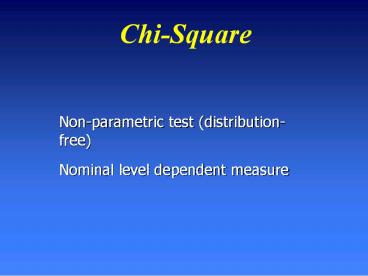Non-parametric test (distribution-free) PowerPoint PPT Presentation
1 / 32
Title: Non-parametric test (distribution-free)
1
Chi-Square
- Non-parametric test (distribution-free)
- Nominal level dependent measure
2
Categorical Variables
- Generally the count of objects falling in each of
several categories. - Examples
- number of fraternity, sorority, and nonaffiliated
members of a class - number of students choosing answers 1, 2, 3, 4,
or 5 - Emphasis on frequency in each category
3
One-way Classification
- Observations sorted on only one dimension
- Example
- Observe children and count red, green, yellow, or
orange Jello choices - Are these colors chosen equally often, or is
there a preference for one over the other?
Cont.
4
One-way--cont.
- Want to compare observed frequencies with
frequencies predicted by null hypothesis - Chi-square test used to compare expected and
observed - Called goodness-of-fit chi-square (c2)
5
Goodness-of-Fit Chi-square
- Fombonne (1989) Season of birth and childhood
psychosis - Are children born at particular times of year
more likely to be diagnosed with childhood
psychosis - He knew the normal children born in each month
- e.g. .8.4 normal children born in January
6
Fombonnes Data
7
Chi-Square (c2)
- Compare Observed (O) with Expected (E)
- Take size of E into account
- With large E, a large (O-E) is not unusual.
- With small E, a large (O-E) is unusual.
8
Calculation of c2
?2.05(11) 19.68
9
(No Transcript)
10
Conclusions
- Obtained ?2 14.58
- df c - 1, where c categories
- Critical value of ?2 on 11 df 19.68
- Since 19.68 gt 14.58, do not reject H0
- Conclude that birth month distribution of
children with psychoses doesnt differ from
normal.
11
Jello Choices
- Red Green Yellow Orange
- 35 20 25 20
- Is there a significant preference for one color
of jello over other colors?
12
- Red Green Yellow Orange
- O 35 20 25 20
- E 25 25 25 25
- X2 (35-25)2/25 (20-25)2/25 (25-25)2/25
(20-25)2/25 6 - There was not one jello color chosen
significantly more often than any other jello
color, X2 (3, N 100) 6, p gt .05
13
Contingency Tables
- Two independent variables
- Are men happier than women?
- Male vs. Female X Happy vs Not Happy
- Intimacy (Yes/No) X Depression/Nondepression
14
Intimacy and Depression
- Everitt Smith (1979)
- Asked depressed and non-depressed women about
intimacy with boyfriend/husband - Data on next slide
15
Data
16
Chi-Square on Contingency Table
- Same formula
- Expected frequencies
- E RT X CT GT
- RT Row total, CT Column total, GT Grand
total
17
Expected Frequencies
- E11 37138/419 12.19
- E12 37281/419 24.81
- E21 382138/419 125.81
- E22 382281/419 256.19
- Enter on following table
18
Observed and Expected Freq.
19
Chi-Square Calculation
20
Degrees of Freedom
- For contingency table, df (R - 1)(C - 1)
- For our example this is (2 - 1)(2 - 1) 1
- Note that knowing any one cell and the marginal
totals, you could reconstruct all other cells.
21
Conclusions
- Since 25.61 gt 3.84, reject H0
- Conclude that depression and intimacy are not
independent. - How one responds to satisfaction with intimacy
depends on whether they are depressed. - Could be depression--gtdissatisfaction, lack of
intimacy --gt depression, depressed people see
world as not meeting needs, etc.
22
Larger Contingency Tables
- Jankowski Leitenberg (pers. comm.)
- Does abuse continue?
- Do adults who are, and are not, being abused
differ in childhood history of abuse? - One variable adult abuse (yes or no)
- Other variable number of abuse categories (out
of 4) suffered as children - Sexual, Physical, Alcohol, or Personal violence
23
(No Transcript)
24
Chi-Square Calculation
25
Conclusions
- 29.62 gt 7.82
- Reject H0
- Conclude that adult abuse is related to childhood
abuse - Increasing levels of childhood abuse are
associated with greater levels of adult abuse. - e.g. Approximately 10 of nonabused children are
later abused as adults.
Cont.
26
Nonindependent Observations
- We require that observations be independent.
- Only one score from each respondent
- Sum of frequencies must equal number of
respondents - If we dont have independence of observations,
test is not valid.
27
Small Expected Frequencies
- Rule of thumb E gt 5 in each cell
- Not firm rule
- Violated in earlier example, but probably not a
problem - More of a problem in tables with few cells.
- Never have expected frequency of 0.
- Collapse adjacent cells if necessary.
Cont.
28
Expected Frequencies--cont.
- More of a problem in tables with few cells.
- Never have expected frequency of 0.
- Collapse adjacent cells if necessary.
29
Effect Size
- Phi and Cramers Phi
- Define N and k
- Not limited to 2X2 tables
Cont.
30
Effect Sizecont.
- Everitt cc data
Cont.
31
Effect SizeOdss Ratio.
- Odds DepLack Intimacy
- 26/112 .232
- Odds Dep No Lack
- 11/270 .041
- Odds Ratio .232/.041 5.69
- Odds Depressed 5.69 times great if experiencing
lack of intimacy.
32
Effect SizeRisk Ratio.
- Risk Depression/Lack Intimacy
- 26/138 .188
- Risk Depression No Lack
- 11/281 .039
- Odds Ratio .188/.039 4.83
- Risk of Depressed 4.83 times greater if
experiencing lack of intimacy.

